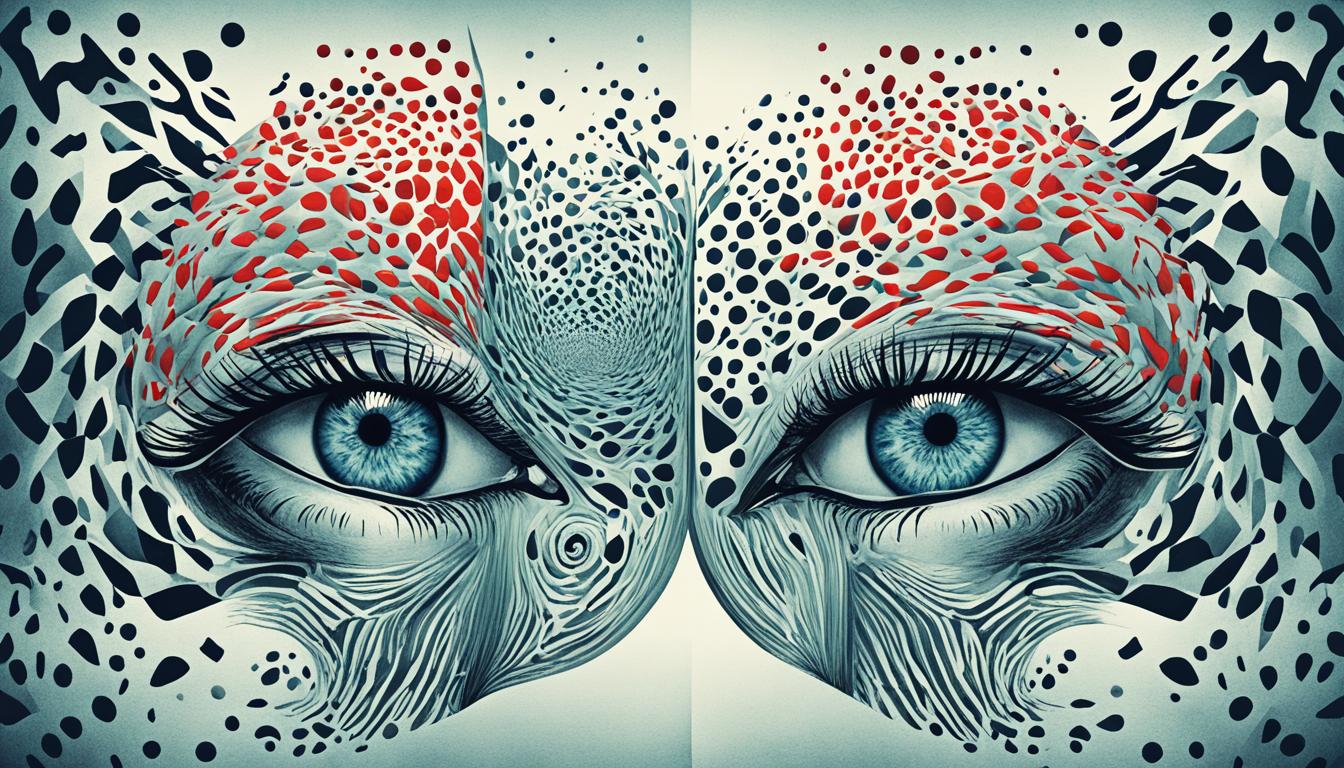Delirium and delusion: are two terms that often intertwine in our understanding of mental states. But are they truly synonymous? Do they represent the same psychological phenomena? is delirium the same as delusion ? In this article, we will embark on a journey of exploration to unravel the mysterious distinctions between delirium and delusion. Prepare to challenge your preconceptions and delve deeper into the intricacies of these intriguing concepts.
Key Takeaways:
- Delirium and delusion are distinct mental states with significant differences.
- Delirium refers to an altered state of consciousness characterized by confusion and cognitive impairment, while delusion is a fixed false belief not based on reality.
- Understanding the symptoms, types, and causes of delirium and delusion is crucial for accurate diagnosis and appropriate management.
- Delirium and delusion have unique features in psychology, and it is important to dispel misconceptions to ensure optimal care for individuals experiencing these mental states.
- By delving into the nuances of delirium and delusion, healthcare professionals can improve patient care and outcomes.
Understanding Delirium: Symptoms and Types
Delirium is a complex condition with a wide range of symptoms and various types. By gaining a deeper understanding of delirium, including its symptoms and types, healthcare professionals can better recognize, diagnose, and manage this condition. This section will explore the spectrum of delirium, including hypoactive and hyperactive delirium, and discuss the incidence and implications of delirium in hospital settings.
Defining the Spectrum of Delirium
The spectrum of delirium encompasses a range of symptoms that vary in severity and presentation. Common symptoms of delirium include:
- Confusion: Delirium often leads to confusion, disorientation, and an inability to focus or concentrate.
- Fluctuating Mental State: Delirium symptoms can fluctuate throughout the day, with periods of increased clarity followed by worsened confusion.
- Cognitive Impairment: Individuals with delirium may experience impaired memory, attention, and problem-solving abilities.
- Altered Sleep-Wake Cycle: Delirium can disrupt the sleep-wake cycle, causing individuals to be overly drowsy or agitated.
These symptoms can present differently depending on the underlying cause of delirium and the individual’s overall health status.
Recognizing Hypoactive and Hyperactive Delirium
Delirium can be categorized into two major subtypes: hypoactive and hyperactive delirium.
Hypoactive Delirium: In hypoactive delirium, individuals may appear lethargic, withdrawn, and have reduced verbal and physical activity. They may exhibit slower movements, reduced responsiveness, and have difficulty initiating or sustaining conversations.
Hyperactive Delirium: Hyperactive delirium is characterized by increased agitation, restlessness, and hyperactivity. Individuals may exhibit rapid speech, purposeless movements, and increased alertness that can escalate into aggression or impulsive behavior.
Recognizing these distinct presentations is crucial for accurate diagnosis and appropriate management of delirium.
Delirium in Hospital Settings: Incidence and Implications
Delirium is particularly prevalent in hospital settings, with a high incidence among older adults and individuals with severe illnesses. Studies have shown that up to 30% of hospitalized patients experience delirium during their stay, with even higher rates among intensive care unit (ICU) patients.
The implications of delirium in hospital settings are significant. Delirium can lead to increased healthcare costs, prolonged hospital stays, and higher mortality rates. It is associated with complications such as falls, pressure ulcers, and functional decline, impacting patient outcomes and quality of care.
Recognizing and effectively managing delirium in hospital settings is crucial to mitigate its impact and improve patient outcomes.
| Delirium Symptoms | Delirium Types |
|---|---|
| Confusion | Hypoactive Delirium |
| Fluctuating Mental State | Hyperactive Delirium |
| Cognitive Impairment | Hyperactive Delirium |
| Altered Sleep-Wake Cycle | Hyperactive Delirium |
Exploring Delusions Among the Delirious: Not All That We Believe
Delusions are a common feature of delirium, but they have distinctive characteristics that set them apart from other manifestations of cognitive impairment. When exploring delusions within the context of delirium, it is essential to define their meaning and distinguish them from delirium-induced hallucinations.
Defining Delusions Within the Delirium Experience
Delusions, in the context of delirium, refer to fixed false beliefs that are not based on reality. These delusions can include a wide range of themes, such as persecutory, grandiose, or paranoid beliefs. They can significantly impact an individual’s thoughts, perceptions, and behavior, leading to significant distress and impairment in daily functioning.
Distinguishing Delusion from Delirium-Induced Hallucinations
It is important to distinguish delusion from delirium-induced hallucinations, as they can present similar but distinct experiences. While delusions involve false beliefs, hallucinations are sensory perceptions that are not based on external stimuli. Hallucinations can occur in various forms, such as auditory, visual, or tactile experiences. By differentiating delusion from hallucination, healthcare professionals can accurately assess and address the specific symptoms that individuals may be experiencing.
Is Delirium the Same as Delusion
Delirium and delusion are distinct mental states that have different characteristics. While they may share some similarities, it is important to clarify their differences. Delirium refers to an altered state of consciousness characterized by confusion and cognitive impairment, whereas delusion refers to a fixed false belief that is not based on reality.
Delirium is a transient condition that often results from an underlying medical condition, such as infection, medication side effects, or metabolic disturbances. It is characterized by acute onset, fluctuating course, and reversible cognitive dysfunction. On the other hand, delusion is a symptom of certain psychiatric disorders, such as schizophrenia or bipolar disorder. Delusions are typically enduring, fixed beliefs that persist despite evidence to the contrary.
While both delirium and delusion involve disturbances in perception and cognition, they have distinct causes and time courses. Delirium arises from physiological factors and is often reversible with appropriate medical intervention. In contrast, delusions are primarily associated with psychiatric disorders and may require long-term management.
It is also important to note that delirium is different from other related concepts, such as psychosis and madness. Psychosis is a broad term that encompasses a range of symptoms, including delusions, hallucinations, and disorganized thinking. Delirium can manifest as a form of psychosis, but not all cases of psychosis are delirious. Madness, on the other hand, is a colloquial term that does not have a specific clinical definition and is not used within the field of psychiatry to describe a specific mental state.
In summary, while delirium and delusion may share some similarities in terms of cognitive disturbances, they are distinct mental states with different causes, time courses, and management approaches. Understanding these differences is crucial for accurate diagnosis and appropriate treatment.

| Aspect | Delirium | Delusion |
|---|---|---|
| Definition | An altered state of consciousness characterized by confusion and cognitive impairment | A fixed false belief that is not based in reality |
| Cause | Underlying medical conditions, such as infection or medication side effects | Psychiatric disorders, such as schizophrenia or bipolar disorder |
| Onset | Acute | Varies (can be chronic) |
| Reversibility | Often reversible with appropriate medical intervention | May require long-term management |
Differentiating Delirium from Dementia and Psychosis
Delirium, dementia, and psychosis are distinct psychiatric conditions that can be challenging to differentiate. However, understanding the subtle differences between them is crucial for accurate diagnosis and effective management.
Identifying the Subtle Differences: Delirium vs. Dementia
While delirium and dementia may share some similarities in terms of cognitive impairment, there are key distinctions that set them apart. Delirium is characterized by an acute onset, fluctuating course, and impaired attention and awareness. On the other hand, dementia is a chronic condition characterized by progressive memory loss, cognitive decline, and difficulty with daily functioning. Delirium is typically reversible once the underlying cause is addressed, whereas dementia is generally irreversible.
The Link Between Delirium and Subsequent Cognitive Decline
Emerging evidence suggests that delirium could be a risk factor for subsequent cognitive decline and the development of dementia. Individuals who experience delirium may be more susceptible to long-term cognitive impairment and accelerated cognitive decline. Therefore, identifying and effectively managing delirium has the potential to mitigate the risk of cognitive decline in the future.
Delirium vs Psychosis: Pinpointing the Diagnostic Nuances
Delirium and psychosis share some overlapping symptoms, such as hallucinations and delusions. However, specific diagnostic nuances can help differentiate between the two. Delirium is characterized by acute-onset confusion, disorientation, and fluctuations in symptoms. Psychosis, on the other hand, involves persistent hallucinations and delusions without significant fluctuations in cognitive function. Additionally, delirium is often secondary to an underlying medical condition, while psychosis can be a primary symptom of psychiatric disorders such as schizophrenia.

| Delirium | Dementia | Psychosis | |
|---|---|---|---|
| Symptoms | Acute onset, fluctuating course, impaired attention and awareness | Progressive memory loss, cognitive decline, difficulty with daily functioning | Hallucinations, delusions |
| Reversibility | Generally reversible once the underlying cause is addressed | Generally irreversible | Depends on the underlying cause or diagnosis |
| Link to Cognitive Decline | This may be a risk factor for subsequent cognitive decline and dementia | Associated with long-term cognitive impairment and accelerated cognitive decline | No direct link to cognitive decline |
| Diagnostic Nuances | Acute-onset confusion, disorientation, fluctuations in symptoms | Gradual memory loss, cognitive decline, stable symptoms | Persistent hallucinations, delusions, stable symptoms |
By delving into these distinctions, healthcare professionals can gain a clearer understanding of each condition and ensure appropriate treatment approaches.
Preventive Measures and Effective Management of Delirium
Preventive measures and effective management strategies are essential in reducing the occurrence and impact of delirium. This section focuses on strategies to mitigate the risks of delirium in the elderly, highlights the role of the healthcare environment in managing delirium symptoms, and emphasizes non-pharmacological interventions as a first-line treatment approach.
Strategies to Mitigate the Risks of Delirium in the Elderly
Taking proactive measures to prevent delirium is crucial, especially in the elderly population. Here are some strategies that healthcare professionals can employ:
- Implement comprehensive geriatric assessments to identify individuals at high risk of delirium.
- Create personalized care plans that address predisposing and precipitating factors.
- Optimize medication management by reducing polypharmacy and minimizing medications with anticholinergic properties.
- Ensure adequate hydration and nutrition, as dehydration and malnutrition can contribute to delirium.
- Provide appropriate pain management, as untreated pain can be a trigger for delirium.
- Facilitate a structured sleep routine and minimize nocturnal disturbances to promote better rest.
Role of the Healthcare Environment in Managing Delirium Symptoms
The healthcare environment plays a significant role in managing delirium symptoms effectively. Creating an environment that promotes patient orientation and reduces confusion can greatly contribute to delirium prevention and management. Healthcare facilities can implement the following measures:
- Ensure adequate lighting and minimize noise levels to enhance sensory perception and reduce disorientation.
- Encourage the use of eyeglasses and hearing aids to optimize sensory function.
- Promote regular social interaction and engagement to maintain cognitive stimulation.
- Use clear signage and labels to aid orientation and minimize confusion.
- Facilitate family involvement and encourage their presence to provide additional support and reassurance.
Non-pharmacological Interventions: A First-Line Treatment Approach
Non-pharmacological interventions are considered a first-line treatment approach for delirium, aiming to manage symptoms and improve patient outcomes. Some effective non-pharmacological interventions include:
- Delirium awareness and education programs for healthcare professionals, patients, and caregivers.
- Early mobilization and physical rehabilitation to maintain functional capacity and prevent complications.
- Structured cognitive stimulation activities and reality orientation therapy to enhance cognitive functioning.
- Multicomponent intervention programs that integrate various approaches and target multiple risk factors simultaneously.
- Environmental modifications, such as using calendars and clocks, to enhance orientation and reduce confusion.
- Music or art therapy to promote relaxation and emotional well-being.
By implementing these preventive measures and effective management strategies, healthcare professionals can improve patient outcomes and enhance the overall quality of care for those at risk of or experiencing delirium.

Conclusion
In conclusion, delirium and delusion are distinctive mental states with significant differences. Understanding the symptoms, types, and causes of delirium and delusion is crucial for accurate diagnosis and appropriate management. By delving into the nuances of these conditions, healthcare professionals can improve patient care and outcomes. Clarifying the differences between delirium and delusion advances our understanding of these complex phenomena and ensures optimal care for individuals experiencing these mental states.
Delirium is characterized by an altered state of consciousness, confusion, and cognitive impairment. It is often seen in hospital settings and can have profound implications for patient well-being. On the other hand, delusion refers to a fixed false belief that is not based in reality. It is a key feature of delirium but has distinct characteristics that differentiate it from other manifestations of cognitive impairment.
By recognizing and understanding the unique features of delirium and delusion, healthcare professionals can accurately diagnose and manage these conditions. This knowledge enables them to implement preventive measures, provide appropriate interventions, and improve patient outcomes. The distinction between delirium and delusion is essential to provide targeted care and support to individuals experiencing these mental states.




